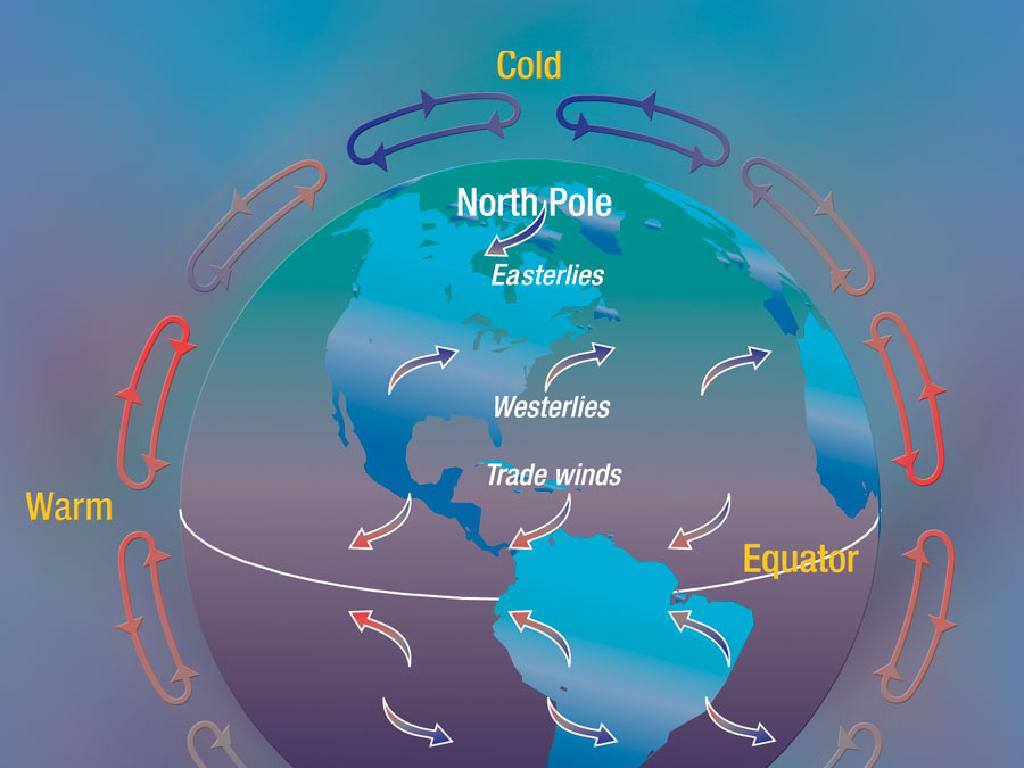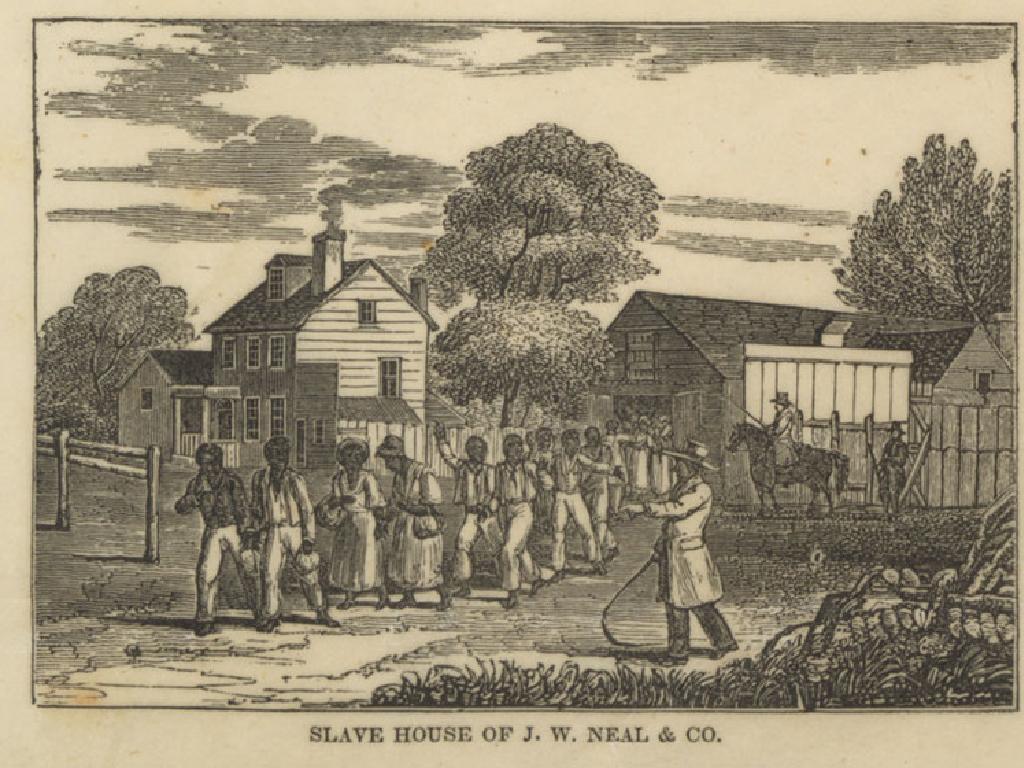Weather Patterns
Subject: Science
Grade: First grade
Topic: Weather
Please LOG IN to download the presentation. Access is available to registered users only.
View More Content
Welcome to Weather Patterns!
– Greet the day and our topic
– Today’s focus: weather patterns
– Exploring: What is weather?
– Weather is the day-to-day state of the atmosphere.
– Discovering patterns together
– We’ll observe how weather changes over days and weeks.
|
Begin the class with a warm greeting to set a positive tone. Introduce the concept of weather patterns as the main topic of the day. Explain that weather is what we experience outside on any given day, like sunshine, rain, or snow. It’s important to convey this in a way that is relatable to first graders, perhaps by discussing the weather they experienced coming to school today. Encourage curiosity by asking them what kind of weather they like and why. This will lead into observing and identifying different weather patterns, helping them understand that weather is not random but follows certain trends. Use simple language and real-life examples to make the concept clear and engaging.
Exploring Weather Patterns
– What is weather?
– Weather is the air outside: warm, cold, wet, or dry.
– Types of weather
– Sunny, rainy, windy, snowy are different weather types.
– Weather changes daily
– Not the same weather every day, it’s always changing.
– Weather varies by location
– Weather can be different in other cities or countries.
|
This slide introduces the concept of weather to first graders. Begin by explaining that weather is the condition of the air outside, which can be felt and observed. It can be warm or cold, wet or dry. Discuss the different types of weather such as sunny, rainy, windy, and snowy, and use visual aids or gestures to help students understand each type. Emphasize that weather is not constant; it changes from day to day and can be different in the morning compared to the evening. Also, explain that weather is not the same everywhere and can vary from one place to another. Encourage students to share what the weather is like outside on that day and to discuss the weather they have experienced when traveling to different places.
Exploring Weather Types
– Sunny days are warm and bright
– Rainy days help plants grow
– Rain provides water for plants to drink
– Snowy days are cold with snowmen
– We wear coats and gloves to stay warm
– Windy days make trees sway
– Wind can move clouds and leaves
|
This slide introduces students to the basic types of weather they experience. Emphasize the characteristics of each weather type and how it affects our environment and activities. For sunny days, discuss the importance of sunlight for us and the Earth. Explain that rain is essential for plant growth and that we use umbrellas to stay dry. For snowy days, talk about snow activities and the need for warm clothing. Describe how wind can be strong enough to move things and that it can be felt but not seen. Encourage students to share their own experiences with different weather types and how it changes what they do outside.
Observing Weather Patterns
– Weather patterns and changes
– Weather patterns help us understand how weather changes over time.
– Observe daily weather
– Look out the window or go outside. What do you see, feel, and hear?
– Be a weather detective
– Like detectives, we’ll watch for clues in the sky to guess tomorrow’s weather!
– Track weather for a week
– Use a chart to record sunny, rainy, or windy days.
|
This slide introduces students to the concept of weather patterns and the importance of observation in understanding how weather changes. Encourage the children to be observant of the weather each day and to record their findings, fostering their curiosity and investigative skills. Provide them with a simple weather tracking chart or have them create their own, where they can mark the weather they observe each day for a week. This activity will help them recognize patterns and make predictions. Discuss the different types of weather they might encounter and what tools they can use to observe the weather, such as their senses or instruments like thermometers and wind vanes.
Our Weather Chart Activity
– Create our weather chart
– Mark daily weather observations
– Is it sunny, rainy, cloudy, or snowy?
– Observe patterns over time
– Look for a pattern after a few weeks
– Understand weather changes
– Learn how weather can change each day
|
This activity is designed to engage first-grade students in observing and recording daily weather conditions. By creating their own weather chart, students will develop an understanding of different weather types and how to identify them. Each day, students will observe the weather and make a corresponding mark on the chart, such as a sun for sunny days or a cloud for cloudy days. Over time, they will be able to see patterns in the weather, such as a string of sunny days followed by rain. This hands-on activity not only teaches about weather patterns but also encourages consistent observation and recording skills. Teachers should provide a variety of weather symbols and assist students in understanding how to use them. Possible activities include drawing their own weather symbols, comparing weather with another class, and predicting future weather based on the observed pattern.
Clothes for Different Weather
– Dressing for sunny days
– Wear hats and sunglasses to protect from the sun
– Outfits for rainy weather
– Raincoats and boots keep us dry
– What to wear on snowy days
– Jackets, gloves, and scarves keep us warm
|
This slide is aimed at teaching first graders the importance of dressing appropriately for different weather conditions. Explain that the weather can affect what we do and what we wear. Use simple language to describe how hats and sunglasses can protect our eyes and skin from the sun. Discuss how raincoats and boots prevent us from getting wet in the rain. Highlight the need for warm clothing like jackets, gloves, and scarves during snowy days to stay warm. Encourage the students to think about what they wear in different weather and why it’s important. You can bring in examples of each type of clothing to show the class or ask students to draw pictures of what they would wear in each kind of weather.
Staying Safe in Different Weathers
– Safety is key in all weathers
– Stay inside during storms
– Lightning can be dangerous, so we avoid going outside
– Drink water in hot weather
– Keeping hydrated and cool prevents heatstroke
– Wear warm clothes when cold
– Coats, hats, and gloves keep us warm and prevent frostbite
|
This slide aims to teach first graders about weather safety. Emphasize the importance of recognizing different weather conditions and knowing how to stay safe. For stormy weather, discuss the dangers of lightning and the importance of staying indoors. When talking about hot weather, explain the need for drinking water and staying cool to avoid heat-related illnesses. For cold weather, highlight the importance of dressing in layers and covering exposed skin to stay warm. Encourage students to share their own experiences with weather and how they stay safe. This will help them understand the practical applications of weather safety.
Class Activity: Weather Charting
– Let’s begin our weather chart activity!
– You’ll each receive a weekly weather chart.
– Draw daily weather on your chart.
– Look out the window, and draw what you see: sunny, rainy, cloudy, etc.
– Next week, we’ll discuss our findings!
|
This activity is designed to engage students with hands-on learning about weather patterns. Distribute a simple weekly weather chart to each student with spaces for each day of the week. Explain that they should observe the weather each day and draw a picture representing the weather they see (e.g., sun for sunny, clouds for cloudy, raindrops for rainy). Encourage creativity and ensure they understand the symbols for different weather types. Next week, have a discussion session where students present their charts and talk about the weather patterns they noticed. This will help them understand the concept of weather patterns and how to observe changes in the weather. Possible variations of the activity could include comparing weather with a classmate, guessing the next day’s weather, or even adding temperature if they have access to a thermometer.






